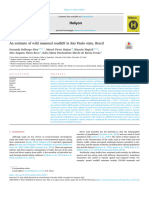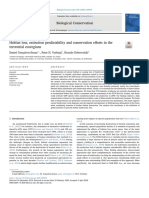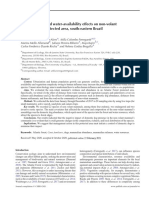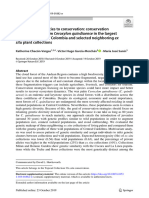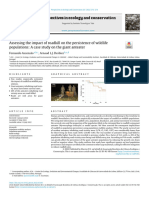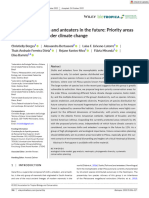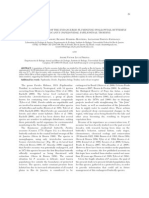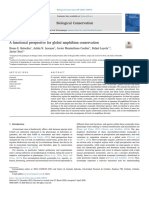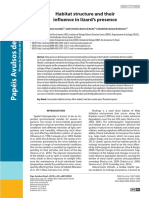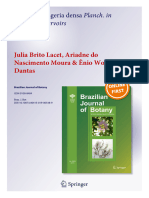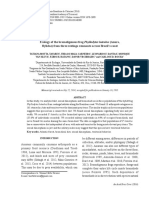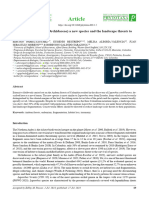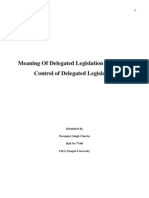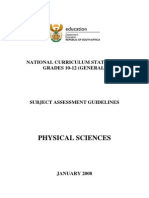DINIZ e BRITO (2013) Ameaças e Viabilidade Do Tamanduá Bandeira Myrmecophaga Tridactyla (Pilosa Myrmecophagidae) em Um Remanescente Protegido de Cerrado Invadido Pela Expansão Urbana No Brasil Central
DINIZ e BRITO (2013) Ameaças e Viabilidade Do Tamanduá Bandeira Myrmecophaga Tridactyla (Pilosa Myrmecophagidae) em Um Remanescente Protegido de Cerrado Invadido Pela Expansão Urbana No Brasil Central
Uploaded by
joaopaulogmCopyright:
Available Formats
DINIZ e BRITO (2013) Ameaças e Viabilidade Do Tamanduá Bandeira Myrmecophaga Tridactyla (Pilosa Myrmecophagidae) em Um Remanescente Protegido de Cerrado Invadido Pela Expansão Urbana No Brasil Central
DINIZ e BRITO (2013) Ameaças e Viabilidade Do Tamanduá Bandeira Myrmecophaga Tridactyla (Pilosa Myrmecophagidae) em Um Remanescente Protegido de Cerrado Invadido Pela Expansão Urbana No Brasil Central
Uploaded by
joaopaulogmOriginal Title
Copyright
Available Formats
Share this document
Did you find this document useful?
Is this content inappropriate?
Copyright:
Available Formats
DINIZ e BRITO (2013) Ameaças e Viabilidade Do Tamanduá Bandeira Myrmecophaga Tridactyla (Pilosa Myrmecophagidae) em Um Remanescente Protegido de Cerrado Invadido Pela Expansão Urbana No Brasil Central
DINIZ e BRITO (2013) Ameaças e Viabilidade Do Tamanduá Bandeira Myrmecophaga Tridactyla (Pilosa Myrmecophagidae) em Um Remanescente Protegido de Cerrado Invadido Pela Expansão Urbana No Brasil Central
Uploaded by
joaopaulogmCopyright:
Available Formats
ZOOLOGIA 30 (2): 151–156, April, 2013
http://dx.doi.org/10.1590/S1984-46702013000200005
Threats to and viability of the giant anteater, Myrmecophaga tridactyla
(Pilosa: Myrmecophagidae), in a protected Cerrado remnant encroached
by urban expansion in central Brazil
Milena F. Diniz1,2 & Daniel Brito1
1
Laboratório de Ecologia Aplicada e Conservação, Departamento de Ecologia, Instituto de Ciências Biológicas, Universidade
Federal de Goiás, Campus Samambaia, Caixa Postal 131, 74001-970, Goiânia, GO, Brazil.
2
Corresponding author. E-mail: midiniz3@hotmail.com
ABSTRACT. Urbanization poses a serious threat to wildlife populations inhabiting native vegetation remnants surrounded
by the expanding urban and suburban sprawl. The close contact with human activities causes not only direct impacts,
such as habitat loss, but also indirect negative effects, such as population isolation, roadkills and anthropogenic fires.
The Parque Nacional de Brasília is a large Cerrado remnant almost completely surrounded by the city of Brasília, in
central Brazil. Here, we use population viability analysis to model the impacts of urbanization on a population of
Myrmecophaga tridactyla (Linnaeus, 1758) inhabiting that park. Our results show that roadkill mortality is by far the
most serious threat to the long-term persistence of the giant anteater in the study site. The implementation of measures
to better control vehicle speed in the vicinity of the park is urgently needed if we expect the giant anteater population
to be effectively protected in the Parque Nacional de Brasília.
KEY WORDS. Extinction; inbreeding; PVA; roadkill; wildfire.
The Cerrado is one of the richest savannas of the world The Parque Nacional de Brasília (42,389 ha) (15°35’-15°45’S,
(MYERS et al. 2000, MITTERMEIER et al. 2005). It is also one of the 48°05’-48°53’W) was created in 1961, and at present it is com-
world’s most threatened ecosystems due to human activities pletely surrounded by urban and suburban sprawl, and its pe-
(MYERS et al. 2000, MITTERMEIER et al. 2005). Therefore, it is no rimeter is almost completely encircled by high-traffic roads
surprise that it is considered as a priority region for global con- (DF-001, DF-095, BR-020 and BR-251).
servation actions (OLSON & DINERSTEIN 2002, SANDERSON et al. 2002, The giant anteater, Myrmecophaga tridactyla (Linnaeus,
H OEKSTRA et al. 2005, M ITTERMEIER et al. 2005, B ROOKS et al. 1758), occurs in open grasslands and savanna habitats in the
2006).The history of large-scale human impacts in the Cerrado, Neotropics (GARDNER 2007). It is listed as threatened both in
where cattle ranching and crop production (mainly soy) have the IUCN Red List of Threatened Species (IUCN 2011) and in
dramatically increased in the last decades, is relatively recent Brazil’s national red list (MACHADO et al. 2008). The major threats
(KLINK & MOREIRA 2002). to the giant anteater are habitat loss (urbanization), roadkills,
The beginning of a serious human occupation of the hunting, fires and feral dogs (IUCN 2011). There is a native
cerrado by humans dates back to the 1950’s, when the country’s giant anteater population in the Parque Nacional de Brasília
new capital (Brasília) was built. Human population growth and (NASCIMENTO & CAMPOS 2011). Our objectives in this contribu-
urbanization quickly followed (IBGE 2011). Up to the present tion are: (1) to estimate the viability of the giant anteater popu-
day, the Cerrado has lost almost 80% of its original vegetation lation in the Parque Nacional de Brasília; (2) to estimate the
(MITTERMEIER et al. 2005), and only 5.5% of the ecoregion is le- relative impacts of isolation due to urbanization, roadkills and
gally protected (a meager 1.4% as strict protected areas) anthropogenic fires on the viability of this population; and (3)
(MITTERMEIER et al. 2005). to propose management procedures that might improve the
The Federal District region (Brasília and its surrounding survival of that population.
municipalities) was listed as an area of extreme high impor-
tance for the conservation of the biodiversity of the Cerrado MATERIAL AND METHODS
(MMA 2007). It is the major urban center in central Brazil.
Brasília was planned to house 500,000 inhabitants, but its cur- To model the viability and the effects of roadkills and
rent population is estimated at 2.6 million inhabitants (IBGE fire on the giant anteater population, we used the PVA soft-
2011). Human population growth and urban sprawl are the ware VORTEX (LACY et al. 2005). We used VORTEX to simu-
main threats to the biodiversity in the Federal District region. late population dynamics and extinction risk for a series of
© 2013 Sociedade Brasileira de Zoologia | www.sbzoologia.org.br | All rights reserved.
152 M. F. Diniz & D. Brito
scenarios: 1) baseline scenario, where we assumed no inbreed- per year). For each scenario, the duration of each simulation
ing, no roadkills and no anthropogenic fires to occur; 2) in- was set at 100 years, and the model was run 1,000 times. The
breeding scenario, where we included the inbreeding carrying capacity for the study site was calculated based on
depression tool in VORTEX (3.14 lethal equivalents, see RALLS an estimated density of 0.4 giant anteaters/km 2 (MIRANDA
et al. 1998), assuming that the urban expansion of Brasília 2004). We assumed that the remnant was fully occupied at
caused the giant anteater population to become isolated; 3) the beginning of a simulation, and set the initial population
wildfire scenario, where we included a 5% chance for the popu- size of each scenario as equal to its carrying capacity. We con-
lation being hit by a wildfire (SILVEIRA et al. 1999); and 4) sidered as viable those scenarios that showed a >95% prob-
roadkill scenarios, where we included mortality due to the ability of persistence during the 100 year period modeled in
high traffic on the roads that surround the Cerrado remnant; the study (SHAFFER 1981, SOULÉ 1987).
we modeled three roadkill mortality intensities (8, 17 or 25 Giant anteaters are solitary and may be active during the
individuals killed per year). Roadkills are a serious threat to day or night, depending on the temperature (CAMILO-ALVES &
the giant anteater’s populations in the Cerrado (CÁCERES 2011). MOURÃO 2006, MOURÃO & MEDRI 2007). It is more active in open
Even though the Parque Nacional de Brasília is almost com- habitats and rests in woodlands (MOURÃO & MEDRI 2007). Their
pletely surrounded by high-traffic roads, there is no monitor- diet consists of ants and termites (GARDNER 2007). A single young
ing program of roadkills set in place for this protected area. is born per reproductive event (GARDNER 2007). Life history data
Therefore, we decided to incorporate this threat in our model used as input in VORTEX was obtained from previous PVA stud-
using three roadkill impact scenarios: 0.05 of the population ies on the giant anteater published in the scientific literature
affected (or eight individuals killed per year); 0.10 (or 17 in- (MIRANDA 2004). A scheme of giant anteater biological data and
dividuals killed per year); and 0.15 (or 25 individuals killed parameter changes in scenarios modeled is given in Table I.
Table I. Life history parameters (based on MIRANDA 2004) and threat scenarios used to model the viability of Myrmecophaga tridactyla
population in Parque Nacional de Brasília. For a detailed description of input parameters, see LACY et al. (2005).
Parameter/Scenario Baseline Inbreeding Fire Roadkill 5% Roadkill 10% Roadkill 15%
Reproductive structure Polygynous baseline baseline baseline baseline baseline
Age 1st reproduction 3 baseline baseline baseline baseline baseline
Longevity 15 baseline baseline baseline baseline baseline
Litter size 1 baseline baseline baseline baseline baseline
Sex ratio (male:female) 1.5:1 baseline baseline baseline baseline baseline
Broods/year 1 baseline baseline baseline baseline baseline
Progeny/brood 1 baseline baseline baseline baseline baseline
Density dependent reproduction Yes baseline baseline baseline baseline baseline
% breeding P(0) 90% baseline baseline baseline baseline baseline
% breeding P(K) 60% baseline baseline baseline baseline baseline
Allee parameter 1 baseline baseline baseline baseline baseline
Steepness parameter 2 baseline baseline baseline baseline baseline
% female breeding 60*((N/K)2)))*(N/(1+N)) baseline baseline baseline baseline baseline
Environmental variation% female breeding 12.5% baseline baseline baseline baseline baseline
% male breeding pool 100% baseline baseline baseline baseline baseline
Mortality rate (1st year) 50 ± 5% baseline baseline baseline baseline baseline
Mortality rate 10 ± 1% baseline baseline baseline baseline baseline
Initial population size 170 baseline baseline baseline baseline baseline
Carrying capacity 170 baseline baseline baseline baseline baseline
Inbreeding depression No Yes baseline baseline baseline baseline
Lethal equivalents – 3.14 baseline baseline baseline baseline
Fire frequency – baseline 5% baseline baseline baseline
Fire severity on survival – baseline 75% baseline baseline baseline
Fire severity on reproduction – baseline 25% baseline baseline baseline
Harvest No baseline baseline 8 individuals/year 17 individuals/year 25 individuals/year
ZOOLOGIA 30 (2): 151–156, April, 2013
Threats to and viability of Myrmecophaga tridactyla in a protected Cerrado remnant 153
RESULTS The results of our models suggest that roadkills are the
most serious threat to the persistence of the giant anteater popu-
The results of the VORTEX modeling show that, in the lation in the Parque Nacional de Brasília (Fig. 1). The giant
baseline scenario (no inbreeding and roadkills), the giant ant- anteater population is very sensible to roadkills, and even the
eater population in the Parque Nacional de Brasília is viable removal of just a few individuals increases the probability of
within the 100 years of the simulation (Fig. 1). Fires, which are a extinction of the population (Fig. 1). The removal of eight or
natural phenomenon in the Cerrado, do not affect population more individuals due to roadkills, in our simulations, resulted
viability (Fig. 1). Under this scenario, the population retains most in a rapid extirpation of the population from the study area
of its original genetic diversity (Fig. 2) after the simulations, but (Fig. 1). Even though the impact of inbreeding is not as drastic
there is a decline in the mean population size (Fig. 3). as that of roadkills, inbreeding also has the potential to threaten
the persistence of the population (Fig. 1). Inbreeding and fires
caused declines in population size in scenarios where the popu-
lation did not go extinct (Fig. 2). Inbreeding and fires also re-
sulted in greater loss of genetic diversity than that predicted
by the baseline scenario (Fig. 3).
Figure 1. Persistence probability estimated under the baseline and
threat scenarios (see text) used to model the population of
Myrmecophaga tridactyla at Parque Nacional de Brasília.
Figure 3. Estimated heterozigosity under the baseline and threat
scenarios (see text) used to model the population of Myrmecophaga
tridactyla at Parque Nacional de Brasília. Heterozigosity estimates
for all scenarios were conducted only up to the point where popu-
lation persistence was >50%.
DISCUSSION
The intense process of urbanization that has taken place
in the last few decades poses a serious hazard for the giant ant-
eater population of the Parque Nacional de Brasília. Roadkills
are the leading human impact on terrestrial vertebrate mortal-
ity (FORMAN & ALEXANDER 1998). Roadkill mortality may result
in population declines, population bottlenecks, and increased
Figure 2. Estimated population size under the baseline and threat extinction risks (FORMAN et al. 2003). Road width, vehicle traf-
scenarios (see text) used to model the population of Myrmecophaga fic levels, paving, and speed limits affect roadkill rates (FORMAN
tridactyla at Parque Nacional de Brasília. Population size estimates & ALEXANDER 1998, ORLOWSKY & NOWAK 2006). Medium-sized and
for all scenarios were conducted only up to the point where popu- large mammals are highly mobile, which increases their chances
lation persistence was >50%. to encounter roads, to try to cross them, and to be killed by
ZOOLOGIA 30 (2): 151–156, April, 2013
154 M. F. Diniz & D. Brito
vehicles. Medium-sized and large mammals are especially sus- carrying capacity in the beginning of all scenarios modeled.
ceptible on two-lane high-speed roads (FORMAN & ALEXANDER One possible limitation of our approach is that some of the
1998). Giant anteaters have already been documented to suf- values of the parameters used were estimated from another
fer from roadkill mortality in the Cerrado (e.g., CÁCERES et al. population (Parque Nacional das Emas, see MIRANDA 2004). Some
2010), and in the study area. The giant anteater population of population parameters are determined by the evolution of the
the Parque Nacional de Brasília is completely surrounded by lineage that originated the species, and show little or no varia-
two-lane high-traffic roads (Fig. 1), and as a consequence, in- tion across different populations of the same species. However,
dividuals dispersing or trying to forage in adjoining areas must other parameters are more affected by the local environmental
cross these roads, becoming vulnerable to passing vehicles. conditions (e.g., mortality rates). The stochastic nature of the
MIRANDA (2004) observed a mortality rate of one individual per viability model already incorporates some of this local varia-
year in the Parque Nacional das Emas, a site with much lower tion. The parameters that could have significant variation across
human density, vehicular traffic and far from major urban cen- populations were exactly those we chose to model different
ters. The human population in Brasília has increased from 1.2 scenarios in order to evaluate local threats that reflect better
million in 1980 to 2.6 million in 2010 (IBGE 2011), and the local reality.
number of vehicles in the capital of Brazil has increased dra- A genetic study conducted at the Parque Nacional das
matically in the last few years. Emas found that the giant anteater population of that area has
Wildfires are a natural phenomenon in the Cerrado. low levels of genetic diversity and high levels of inbreeding
However, the large human population living close to the Parque (COLLEVATTI et al. 2007). The population estimated for the Parque
Nacional de Brasília causes a disruption in the natural fire re- Nacional de Brasília is much smaller than that inhabiting the
gime of the Cerrado, and anthropogenic fires occur more fre- Parque Nacional das Emas. Our results show that if urbaniza-
quently. Our simulations show that genetic diversity is lost and tion results in isolation of the giant anteater population and
the population declines in the presence of fires. Wildfires have inbreeding, this might increase the risk of extinction and cause
already been reported to kill giant anteaters in the Cerrado, population declines, but inbreeding is not expected to cause
culling a significant portion of the population (SILVEIRA et al. loss of genetic diversity (see results above). However, we did
1999). Individuals suffer from the direct mortality due to the not model a scenario with the possible synergistic effects of
impacts of fires, but those who survive are capable of using fire and inbreeding. Fires may depress population size and cause
burnt areas to forage (PRADA & MARINHO-F ILHO 2004). Giant ant- a genetic bottleneck, resulting in loss of genetic diversity (e.g.,
eaters can escape from fires by taking refuge in gallery forests COLLEVATTI et al. 2007).
along river banks or fleeing to areas adjacent to the Parque The results of our simulations suggest that the three sce-
Nacional de Brasília (SILVEIRA et al. 1999). Unfortunately, due to narios we have modeled threat the giant anteater population
the isolation of the national park, when a fire occurs, individu- under scrutiny in the following order of importance: roadkills,
als fleeing the affected area will have to cross the roads sur- fires, inbreeding. In order to improve the chances of survival
rounding the park, increasing the chances of roadkills. of the giant anteater population at the Parque Nacional de
The predictions derived from our simulations might be Brasília, we recommend that some management actions are
viewed as optimistic because we did not model scenarios evalu- implemented. Because our analysis shows that roadkills are by
ating other known threats to the giant anteater population in far the most serious threat, we suggest that speed bumps and
the study area, such as feral dogs (LACERDA et al. 2009). It has speed traps (pardais in Portuguese) are installed in the roads
been demonstrated that feral dogs cause an edge effect in the close to the park. Speed limits in the vicinity to the park should
Brasília Parque Nacional de Brasília, and giant anteaters avoid also be re-evaluated, and maximum speeds decreased. These
the outer skirts of the park (LACERDA et al. 2009). Dogs come measures should be complemented by a more strict enforce-
from urban and suburban areas close to the park: stray dogs ment of traffic laws and more rigorous punishment for infrac-
enter the park through a garbage dump located in the vicinity tions. The construction of wildlife overpasses could also mitigate
of the protected area (LACERDA et al. 2009). Even though giant roadkills. Decreasing roadkill mortality is likely to bring great
anteaters are hunted in certain areas (e.g., KOSTER 2008) there is benefits not only for the giant anteater population, but also
no evidence of that they are hunted [by wild dogs] in the Parque for other wide-ranging wildlife species found at the site (e.g.,
Nacional de Brasília. However, even though humans are not the manned wolf). We also recommend that a fire manage-
hunting giant anteaters in the study site, there is the possibil- ment action plan, specifically for the study area, should be
ity that feral dog packs may hunt down giant anteaters, as they developed. Even though wildfires are a natural process in the
come into the national park. Feral dog attacks have been listed Cerradoand should not be controlled/suppressed, anthropo-
as a possible cause for the decline of the giant anteater popula- genic fires should be extinguished as fast as possible.
tion in the Parque Nacional de Brasília (HOROWITZ 1992). An- Management actions to counteract the negative effects
other reason why our results may be perceived as optimistic is of inbreeding in the short term could include the construction
that we have considered the giant anteater population at its of wildlife passes (e.g., CLEVENGER & WALTHO 2000, VAN WIEREN &
ZOOLOGIA 30 (2): 151–156, April, 2013
Threats to and viability of Myrmecophaga tridactyla in a protected Cerrado remnant 155
WORM 2001), to facilitate connectivity between the giant ant- 2003. Road ecology: science and solutions. Washington,
eater population in the Parque Nacional de Brasília and other Island Press.
populations nearby. Besides improving connectivity, such pas- GARDNER, A.L. 2007. Mammals of South America volume 1:
sages could help decrease roadkill mortality, and provide an marsupials, xenarthrans, shrews and bats. Chicago, The
escape route for individuals when fires hit the park. Because University of Chicago Press.
there is yet too much to be investigated about the population HOEKSTRA, J.M.; T.M. BOUCHER; T.H. RICKETTS & C. ROBERTS. 2005.
parameters of the giant anteater at the Parque Nacional de Confronting a biome crisis: global disparities of habitat loss
Brasília, we also suggest the implementation of a population and protection. Ecology Letters 8 (1): 23-29.
monitoring program for the giant anteater. Such program could HOROWITZ, C. 1992. Plano de manejo do Parque Nacional de
generate site-specific population parameters to refine the vi- Brasília: avaliação da metodologia de planejamento ado-
ability models in the future. tada, execução e resultados alcançados no decênio 79/
The creation, implementation and enforcement of a 89. Brasília, Universidade de Brasília.
management plan for the giant anteater population in the IBGE. 2011. Estimativas populacionais para os municípios
Parque Nacional de Brasília are of utmost importance. It may brasileiros. Brasília, IBGE.
give one of the first inhabitants of Brasília (its native giant IUCN. 2011. IUCN Red List of threatened species. Gland,
anteater population), a chance to coexist with the new neigh- IUCN/SSC.
bors in town. KLINK, C.A. & A.G. MOREIRA. 2002. Past and current human
occupation and land use, p. 69-90. In: P.S. OLIVEIRA & R.J.
ACKNOWLEDGEMENTS MARQUIS (Eds). The Cerrados of Brazil: ecology and natu-
ral history of a Neotropical savanna. New York, Columbia
Milena F. Diniz thanks CAPES for the PIBIC scholarship. University Press.
Daniel Brito’s work is funded by CNPq (Project # 305631/2009-8). KOSTER, J.M. 2008. Giant anteaters (Myrmecophaga tridactyla)
killed by hunters with dogs in the Bosawas Biosphere Reser-
LITERATURE CITED ve, Nicaragua. The Southwestern Naturalist 53 (3): 414-
416.
BROOKS , T.M.; R.A. MITTERMEIER; G.A.B. DA FONSECA; J. GERLACH; M. LACERDA, A.C.R.; W.M. TOMAS & J. MARINHO-FILHO. 2009. Domestic
HOFFMANN; J.F. LAMOREUX; C.G. MITTERMEIER; J.D. PILGRIM & A.S.L. dogs as an edge effect in the Brasília National Park, Brazil:
RODRIGUES. 2006. Global biodiversity conservation priorities. interactions with native mammals. Animal Conservation
Science 313: 58-61. 12 (5): 477-487.
CÁCERES, N.C. 2011. Biological characeristics influence mammal LACY, R.C.; M. BORBAT & J.P. POLLAK. 2005. VORTEX: A Stochastic
road kill in an Atlantic Forest – Cerrado interface in south- simulation of the extinction process. Version 9.99. Illinois,
western Brazil. Italian Journal of Zoology 78 (3): 379-389. Chicago Zoological Society.
CÁCERES, N.C.; W. HANNIBAL; D.R. FREITAS; E.L. S ILVA; C. ROMAN & J. MACHADO, A.B.M.; G.M. DRUMMOND & A.P. PAGLIA. 2008. Livro
C ASELLA. 2010. Mammal occurrence and roadkill in two vermelho da fauna brasileira ameaçada de extinção.
adjacent ecoregions (Atlantic Forest and Cerrado) in south- Brasília, Ministério do Meio Ambiente.
western Brazil. Zoologia 27 (5): 709-717. MIRANDA, G.H.B. 2004. Ecologia e conservação do tamanduá-
CAMILO-ALVES, C.S.P. & G. MOURÃO. 2006. Responses of a specialized bandeira (Myrmecophaga tridactyla, Linnaeus, 1758) no
insectivorous mammal (Myrmecophaga tridactyla) to variation Parque Nacional das Emas. Brasília, Universidade de
in ambient temperature. Biotropica 38 (1): 52-56. Brasília.
CLEVENGER, A.P. & N. WALTHO. N. 2000. Factors influencing the MITTERMEIER, R.A.; P.R. GIL; M. HOFFMAN; J. PILGRIM; T. BROOKS; C.G.
effectiveness of wildlife underpasses in Banff National Park, MITTERMEIER; J. LAMOREUX & G.A.B. DA FONSECA. 2005. Hotspots
Alberta, Canada. Conservation Biology 14 (1): 47-56. revisited: Earth’s biologically richest and most endangered
COLLEVATTI, R.G.; K.C.E. LEITE; G.H.B. MIRANDA & F.H.G. RODRIGUES. terrestrial ecoregions. Mexico City, CEMEX.
2007. Evidence of high inbreeding in a population of the MMA. 2007. Áreas prioritárias para a conservação, uso sus-
endangered giant anteater, Myrmecophaga tridactyla tentável e repartição dos benefícios da biodiversidade
(Myrmecophagidae), from Emas National Park, Brazil. brasileira. Brasília, Ministério do Meio Ambiente, Série
Genetics and Molecular Biology 30 (1): 112-120. Biodiversidade 31.
FORMAN, R.T.T. & L.E. ALEXANDER. 1998. Roads and their major M OURÃO, G. & I.G. M EDRI . 2007. Activity of a specialized
ecological effects. Annual Review of Ecology and insectivorous mammal (Myrmecophaga tridactyla) in the Pan-
Systematics 29 (1): 207-231. tanal of Brazil. Journal of Zoology 271 (2): 187-192.
FORMAN, R.T.T.; D. SPERLING; J.E. BISSONETTE; A.P. CLEVENGER; C.D. MYERS , N.; R.A. MITTERMEIER; C.G. MITTERMEIER; G.A.B. DA FONSECA
CUTSHALL; V.H. DALE; L. FAHRIG; R. FRANCE ; C.R. GOLDMAN; K. & J. K ENT. 2000. Biodiversity hotspots for conservation
HEANUE; J.A. JONES; F.J. SWANSON; T. TURRENTINE & T.C. WINTER. priorities. Nature 403: 853-858.
ZOOLOGIA 30 (2): 151–156, April, 2013
156 M. F. Diniz & D. Brito
NASCIMENTO, J.L. & I.B. CAMPOS. 2011. Atlas da fauna brasileira Conservation Biology 2: 185-93.
ameaçada de extinção em unidades de conservação fe- SANDERSON, E.W.; M. JAITEH; M.A. LEVY; K.H. REDFORD; A.V. WANNEBO
derais. Brasília, ICMBio. & G. WOOLMER. 2002. The human footprint and the last of
OLSON, D.M. & E. DINERSTEIN. 2002. The global 200: priority the wild. BioScience 52 (10): 891-904.
ecoregions for global conservation. Annals of the Missouri S HAFFER, M.L. 1981. Minimum population sizes for species
Botanical Garden 89 (2): 199-224. conservation. BioScience 31: 131-134.
ORLOWSKI, G. & L. NOWAK. 2006. Factors influencing mammal SILVEIRA, L.; F.H.G. RODRIGUES; A.T.A. JÁCOMO & J.A.F. DINIZ-FILHO.
roadkills in the agricultural landscape of south-western 1999. Impact of wildfires on the megafauna of Emas National
Poland. Polish Journal of Ecology 54 (2): 283-294. Park, central Brazil. Oryx 33 (2): 108-114.
P RADA , M. & J. MARINHO -FILHO . 2004. Effects of fire on the S OULÉ , M.E. 1987. Viable populations for conservation.
abundance of Xenarthrans in Mato Grosso, Brazil. Austral Cambridge, Cambridge University Press.
Ecology 29 (5): 568-573. VAN WIEREN, S.E. & P.B. WORM. 2001. The use of a motorway
RALLS, K.; J.D. BALLOU & A.R. TEMPLETON. 1988. Estimates of lethal wildlife overpass by large mammals. Netherlands Journal
equivalents and the cost of inbreeding in mammals. of Zoology 51 (1): 97-105.
Submitted: 27.IV.2012; Accepted: 21.XII.2012.
Editorial responsibility: Heraldo L. de Vasconcelos
ZOOLOGIA 30 (2): 151–156, April, 2013
You might also like
- Bogoni_etal_202 - Potential distribution of piscivores across the Atlantic Forest - bats and marsupiaisNo ratings yetBogoni_etal_202 - Potential distribution of piscivores across the Atlantic Forest - bats and marsupiais12 pages
- Taxonomic Phylogenetic and Functional Diversity ofNo ratings yetTaxonomic Phylogenetic and Functional Diversity of8 pages
- Biological Conservation: Policy AnalysisNo ratings yetBiological Conservation: Policy Analysis8 pages
- CONICET_Digital_Nro.59d39234-07bf-4112-a66a-95c6d8ee2215_ANo ratings yetCONICET_Digital_Nro.59d39234-07bf-4112-a66a-95c6d8ee2215_A7 pages
- Local and Continental Determinants of Giant Anteater (Myrmecophaga Tridactyla) Abundance: Biome, Human and Jaguar Roles in Population RegulationNo ratings yetLocal and Continental Determinants of Giant Anteater (Myrmecophaga Tridactyla) Abundance: Biome, Human and Jaguar Roles in Population Regulation7 pages
- Parasitism of Bat Flies (Nycteribiidae and Streblidae) On Bats in Urban Environments: Lower Prevalence, Infracommunities, and SpecificityNo ratings yetParasitism of Bat Flies (Nycteribiidae and Streblidae) On Bats in Urban Environments: Lower Prevalence, Infracommunities, and Specificity9 pages
- 2024, Santana Et Al - Endemic Amphibians of The Cerrado and Caatinga Species Richness, Geographic Range and ConservationNo ratings yet2024, Santana Et Al - Endemic Amphibians of The Cerrado and Caatinga Species Richness, Geographic Range and Conservation11 pages
- Monteiro-Alves Et Al 2021 - Domestic Dogs and Water-Availability Effects On Non-Volant Mammals in A Protected Area, South-Eastern BrazilNo ratings yetMonteiro-Alves Et Al 2021 - Domestic Dogs and Water-Availability Effects On Non-Volant Mammals in A Protected Area, South-Eastern Brazil11 pages
- Beltrami Etal2021 SmallWildcats UnderPressure Free-RangingDogs&Cats MediterraneanLandscapesChileNo ratings yetBeltrami Etal2021 SmallWildcats UnderPressure Free-RangingDogs&Cats MediterraneanLandscapesChile18 pages
- Animal Conservation - 2023 - Bonenfant - Cast Away on Mindoro Island Lack of Space Limits Population Growth of TheNo ratings yetAnimal Conservation - 2023 - Bonenfant - Cast Away on Mindoro Island Lack of Space Limits Population Growth of The12 pages
- Ribeiro Et Al - 2016 - Phylogenetic Impoverishment of Plant Communities Following Chronic HumanNo ratings yetRibeiro Et Al - 2016 - Phylogenetic Impoverishment of Plant Communities Following Chronic Human10 pages
- Chacon-Vargas2019 Article FromKeystoneSpeciesToConservatNo ratings yetChacon-Vargas2019 Article FromKeystoneSpeciesToConservat20 pages
- Edge and Land Use Efects On Dung Beetles (Coleoptera: Scarabaeidae: Scarabaeinae) in Brazilian Cerrado VegetationNo ratings yetEdge and Land Use Efects On Dung Beetles (Coleoptera: Scarabaeidae: Scarabaeinae) in Brazilian Cerrado Vegetation14 pages
- Deforestation Fires and Lack of Governance Are DisNo ratings yetDeforestation Fires and Lack of Governance Are Dis10 pages
- VIEIRA - Et Al. 2024 - Some Bats Are HereNo ratings yetVIEIRA - Et Al. 2024 - Some Bats Are Here14 pages
- Ascenção e Desbies 2022 Atropelamentos em RodoviasNo ratings yetAscenção e Desbies 2022 Atropelamentos em Rodovias7 pages
- Assessing The Distribution of A Species-Rich GroupNo ratings yetAssessing The Distribution of A Species-Rich Group12 pages
- Deforestation and Bird Habitat Loss in ColombiaNo ratings yetDeforestation and Bird Habitat Loss in Colombia35 pages
- Insect Science - 2012 - Korasaki - Using Dung Beetles To Evaluate The Effects of Urbanization On Atlantic ForestNo ratings yetInsect Science - 2012 - Korasaki - Using Dung Beetles To Evaluate The Effects of Urbanization On Atlantic Forest14 pages
- Human Wildlife Conflicts To Communities Surrounding Mikumi National Parks in Tanzania: A Case of Selected VillagesNo ratings yetHuman Wildlife Conflicts To Communities Surrounding Mikumi National Parks in Tanzania: A Case of Selected Villages8 pages
- Caraballo Et Al. 2023 - Journal of MammalogyNo ratings yetCaraballo Et Al. 2023 - Journal of Mammalogy13 pages
- Biotropica - 2022 - Borges - Safeguarding Sloths and Anteaters in The Future PRNo ratings yetBiotropica - 2022 - Borges - Safeguarding Sloths and Anteaters in The Future PR12 pages
- Variation in Mesopredator Abundance and Nest Predation Rate of The Endangered Strange-Tailed Tyrant (Alectrurus Risora)No ratings yetVariation in Mesopredator Abundance and Nest Predation Rate of The Endangered Strange-Tailed Tyrant (Alectrurus Risora)16 pages
- 2022 - Moura Et Al - Efeitos de Um Megaincêndio Na Comunidade de Fungos Micorrízicos Arb .... BrasilNo ratings yet2022 - Moura Et Al - Efeitos de Um Megaincêndio Na Comunidade de Fungos Micorrízicos Arb .... Brasil11 pages
- Palmeira Et Al. 2015 Livestock Predation by Puma (Puma Concolor) in The HighlandsNo ratings yetPalmeira Et Al. 2015 Livestock Predation by Puma (Puma Concolor) in The Highlands13 pages
- A Functional Perspective For Global Amphibian ConservationNo ratings yetA Functional Perspective For Global Amphibian Conservation9 pages
- Costa & Lorenzo 2009 Biology, Diversity and Strategies For The Monitoring and Control of Triatomines - Chagas Disease VectorsNo ratings yetCosta & Lorenzo 2009 Biology, Diversity and Strategies For The Monitoring and Control of Triatomines - Chagas Disease Vectors6 pages
- ABREU, R. e RODRIGUES, P. 2010. Exotic Tree Artocarpus Heterophyllus (Moraceae) Invades The Brazilian Atlantic RainforestNo ratings yetABREU, R. e RODRIGUES, P. 2010. Exotic Tree Artocarpus Heterophyllus (Moraceae) Invades The Brazilian Atlantic Rainforest13 pages
- Chapter 1: Carnivores in Human-Influenced LandscapesNo ratings yetChapter 1: Carnivores in Human-Influenced Landscapes1 page
- A Spatial and Temporal Assessment of Human-Snake Encounters in Urban and Peri-Urban Areas of Windhoek, NamibiaNo ratings yetA Spatial and Temporal Assessment of Human-Snake Encounters in Urban and Peri-Urban Areas of Windhoek, Namibia9 pages
- Habitat Structure and Their Influence in Lizard's Presence: Pap. Avulsos Zool., 2019 v.59: E20195959No ratings yetHabitat Structure and Their Influence in Lizard's Presence: Pap. Avulsos Zool., 2019 v.59: E2019595910 pages
- Nagy Reis Et Al 2017 Animal ConservationNo ratings yetNagy Reis Et Al 2017 Animal Conservation12 pages
- Effects of Habitat Fragmentation On The Persistence of Medium and Large Mammal Species in The Brazilian Savanna of Goiás StateNo ratings yetEffects of Habitat Fragmentation On The Persistence of Medium and Large Mammal Species in The Brazilian Savanna of Goiás State9 pages
- Invasion of Egeria Densa Planch. in Semiarid ReservoirsNo ratings yetInvasion of Egeria Densa Planch. in Semiarid Reservoirs9 pages
- Castillo Etal2020 RecentREVIEW FireBehaviorEffects NativeVegetation CentralChileNo ratings yetCastillo Etal2020 RecentREVIEW FireBehaviorEffects NativeVegetation CentralChile12 pages
- Alvarez_etal_2021 - The ghost vampire spatio-temporal distribution and conservation status of the largest bat in the AmericasNo ratings yetAlvarez_etal_2021 - The ghost vampire spatio-temporal distribution and conservation status of the largest bat in the Americas19 pages
- Motta Tavaresetal.2016 EcologyofPhyllodytesluteolusNo ratings yetMotta Tavaresetal.2016 EcologyofPhyllodytesluteolus12 pages
- Calixto & Morato - 2017 - Herpetofauna Recorded Fauna Rescue Caatinga João Câmara-Rio Grande Do Norte - Check - ListNo ratings yetCalixto & Morato - 2017 - Herpetofauna Recorded Fauna Rescue Caatinga João Câmara-Rio Grande Do Norte - Check - List12 pages
- Large Carpenter Bees Show High Dispersal in A TropNo ratings yetLarge Carpenter Bees Show High Dispersal in A Trop10 pages
- The Impacts of Domestic Dogs Canis Familiaris On Wildlife in Two Brazilian Hotspots and Implications For ConservationNo ratings yetThe Impacts of Domestic Dogs Canis Familiaris On Wildlife in Two Brazilian Hotspots and Implications For Conservation14 pages
- Ecosphere - 2016 - Bellard - Major Drivers of Invasion Risks Throughout The WorldNo ratings yetEcosphere - 2016 - Bellard - Major Drivers of Invasion Risks Throughout The World14 pages
- Christian Marriage Registration - Bishop, Pastor and Licensee - Login - Portal - User ManualNo ratings yetChristian Marriage Registration - Bishop, Pastor and Licensee - Login - Portal - User Manual17 pages
- Relationships and Links Between The Various SAP Database TablesNo ratings yetRelationships and Links Between The Various SAP Database Tables29 pages
- 12 Modelling Horror Stories and Spreadsheet Disasters Mazars UKNo ratings yet12 Modelling Horror Stories and Spreadsheet Disasters Mazars UK23 pages
- Exploration of TCP Parameters For Enhanced Performance in A Datacenter EnvironmentNo ratings yetExploration of TCP Parameters For Enhanced Performance in A Datacenter Environment5 pages
- Preliminary Report To Leaning Tower ConstructionNo ratings yetPreliminary Report To Leaning Tower Construction5 pages
- Coal Dust Particle Size Survey of US Mines: Michael J. Sapko, Kenneth L. Cashdollar, Gregory M. GreenNo ratings yetCoal Dust Particle Size Survey of US Mines: Michael J. Sapko, Kenneth L. Cashdollar, Gregory M. Green5 pages
- C C programmer s reference 3rd ed Edition Schildt download pdf100% (3)C C programmer s reference 3rd ed Edition Schildt download pdf81 pages
- 200Th Report On Trial by Media Free Speech and Fair Trial UnderNo ratings yet200Th Report On Trial by Media Free Speech and Fair Trial Under120 pages
- Reviewer Agrarian Law and Social Legislation 1No ratings yetReviewer Agrarian Law and Social Legislation 14 pages
- Sapphire International School, Noida SESSION 2019-20 Schedule For Internal Assessment (Term I) Class: VINo ratings yetSapphire International School, Noida SESSION 2019-20 Schedule For Internal Assessment (Term I) Class: VI2 pages
- Gerona Vs Secretary Administrative Case VS: You've Visited This Page 2 Times. Last Visit: 7/13/18No ratings yetGerona Vs Secretary Administrative Case VS: You've Visited This Page 2 Times. Last Visit: 7/13/182 pages
- Đề Thi Thử Tuyển Sinh Vào 10 Trường Lương Thế VinhNo ratings yetĐề Thi Thử Tuyển Sinh Vào 10 Trường Lương Thế Vinh4 pages
- Bogoni_etal_202 - Potential distribution of piscivores across the Atlantic Forest - bats and marsupiaisBogoni_etal_202 - Potential distribution of piscivores across the Atlantic Forest - bats and marsupiais
- Taxonomic Phylogenetic and Functional Diversity ofTaxonomic Phylogenetic and Functional Diversity of
- CONICET_Digital_Nro.59d39234-07bf-4112-a66a-95c6d8ee2215_ACONICET_Digital_Nro.59d39234-07bf-4112-a66a-95c6d8ee2215_A
- Local and Continental Determinants of Giant Anteater (Myrmecophaga Tridactyla) Abundance: Biome, Human and Jaguar Roles in Population RegulationLocal and Continental Determinants of Giant Anteater (Myrmecophaga Tridactyla) Abundance: Biome, Human and Jaguar Roles in Population Regulation
- Parasitism of Bat Flies (Nycteribiidae and Streblidae) On Bats in Urban Environments: Lower Prevalence, Infracommunities, and SpecificityParasitism of Bat Flies (Nycteribiidae and Streblidae) On Bats in Urban Environments: Lower Prevalence, Infracommunities, and Specificity
- 2024, Santana Et Al - Endemic Amphibians of The Cerrado and Caatinga Species Richness, Geographic Range and Conservation2024, Santana Et Al - Endemic Amphibians of The Cerrado and Caatinga Species Richness, Geographic Range and Conservation
- Monteiro-Alves Et Al 2021 - Domestic Dogs and Water-Availability Effects On Non-Volant Mammals in A Protected Area, South-Eastern BrazilMonteiro-Alves Et Al 2021 - Domestic Dogs and Water-Availability Effects On Non-Volant Mammals in A Protected Area, South-Eastern Brazil
- Beltrami Etal2021 SmallWildcats UnderPressure Free-RangingDogs&Cats MediterraneanLandscapesChileBeltrami Etal2021 SmallWildcats UnderPressure Free-RangingDogs&Cats MediterraneanLandscapesChile
- Animal Conservation - 2023 - Bonenfant - Cast Away on Mindoro Island Lack of Space Limits Population Growth of TheAnimal Conservation - 2023 - Bonenfant - Cast Away on Mindoro Island Lack of Space Limits Population Growth of The
- Ribeiro Et Al - 2016 - Phylogenetic Impoverishment of Plant Communities Following Chronic HumanRibeiro Et Al - 2016 - Phylogenetic Impoverishment of Plant Communities Following Chronic Human
- Chacon-Vargas2019 Article FromKeystoneSpeciesToConservatChacon-Vargas2019 Article FromKeystoneSpeciesToConservat
- Edge and Land Use Efects On Dung Beetles (Coleoptera: Scarabaeidae: Scarabaeinae) in Brazilian Cerrado VegetationEdge and Land Use Efects On Dung Beetles (Coleoptera: Scarabaeidae: Scarabaeinae) in Brazilian Cerrado Vegetation
- Deforestation Fires and Lack of Governance Are DisDeforestation Fires and Lack of Governance Are Dis
- Ascenção e Desbies 2022 Atropelamentos em RodoviasAscenção e Desbies 2022 Atropelamentos em Rodovias
- Assessing The Distribution of A Species-Rich GroupAssessing The Distribution of A Species-Rich Group
- Insect Science - 2012 - Korasaki - Using Dung Beetles To Evaluate The Effects of Urbanization On Atlantic ForestInsect Science - 2012 - Korasaki - Using Dung Beetles To Evaluate The Effects of Urbanization On Atlantic Forest
- Human Wildlife Conflicts To Communities Surrounding Mikumi National Parks in Tanzania: A Case of Selected VillagesHuman Wildlife Conflicts To Communities Surrounding Mikumi National Parks in Tanzania: A Case of Selected Villages
- Biotropica - 2022 - Borges - Safeguarding Sloths and Anteaters in The Future PRBiotropica - 2022 - Borges - Safeguarding Sloths and Anteaters in The Future PR
- Variation in Mesopredator Abundance and Nest Predation Rate of The Endangered Strange-Tailed Tyrant (Alectrurus Risora)Variation in Mesopredator Abundance and Nest Predation Rate of The Endangered Strange-Tailed Tyrant (Alectrurus Risora)
- 2022 - Moura Et Al - Efeitos de Um Megaincêndio Na Comunidade de Fungos Micorrízicos Arb .... Brasil2022 - Moura Et Al - Efeitos de Um Megaincêndio Na Comunidade de Fungos Micorrízicos Arb .... Brasil
- Palmeira Et Al. 2015 Livestock Predation by Puma (Puma Concolor) in The HighlandsPalmeira Et Al. 2015 Livestock Predation by Puma (Puma Concolor) in The Highlands
- A Functional Perspective For Global Amphibian ConservationA Functional Perspective For Global Amphibian Conservation
- Costa & Lorenzo 2009 Biology, Diversity and Strategies For The Monitoring and Control of Triatomines - Chagas Disease VectorsCosta & Lorenzo 2009 Biology, Diversity and Strategies For The Monitoring and Control of Triatomines - Chagas Disease Vectors
- ABREU, R. e RODRIGUES, P. 2010. Exotic Tree Artocarpus Heterophyllus (Moraceae) Invades The Brazilian Atlantic RainforestABREU, R. e RODRIGUES, P. 2010. Exotic Tree Artocarpus Heterophyllus (Moraceae) Invades The Brazilian Atlantic Rainforest
- Chapter 1: Carnivores in Human-Influenced LandscapesChapter 1: Carnivores in Human-Influenced Landscapes
- A Spatial and Temporal Assessment of Human-Snake Encounters in Urban and Peri-Urban Areas of Windhoek, NamibiaA Spatial and Temporal Assessment of Human-Snake Encounters in Urban and Peri-Urban Areas of Windhoek, Namibia
- Habitat Structure and Their Influence in Lizard's Presence: Pap. Avulsos Zool., 2019 v.59: E20195959Habitat Structure and Their Influence in Lizard's Presence: Pap. Avulsos Zool., 2019 v.59: E20195959
- Effects of Habitat Fragmentation On The Persistence of Medium and Large Mammal Species in The Brazilian Savanna of Goiás StateEffects of Habitat Fragmentation On The Persistence of Medium and Large Mammal Species in The Brazilian Savanna of Goiás State
- Invasion of Egeria Densa Planch. in Semiarid ReservoirsInvasion of Egeria Densa Planch. in Semiarid Reservoirs
- Castillo Etal2020 RecentREVIEW FireBehaviorEffects NativeVegetation CentralChileCastillo Etal2020 RecentREVIEW FireBehaviorEffects NativeVegetation CentralChile
- Alvarez_etal_2021 - The ghost vampire spatio-temporal distribution and conservation status of the largest bat in the AmericasAlvarez_etal_2021 - The ghost vampire spatio-temporal distribution and conservation status of the largest bat in the Americas
- Motta Tavaresetal.2016 EcologyofPhyllodytesluteolusMotta Tavaresetal.2016 EcologyofPhyllodytesluteolus
- Calixto & Morato - 2017 - Herpetofauna Recorded Fauna Rescue Caatinga João Câmara-Rio Grande Do Norte - Check - ListCalixto & Morato - 2017 - Herpetofauna Recorded Fauna Rescue Caatinga João Câmara-Rio Grande Do Norte - Check - List
- Large Carpenter Bees Show High Dispersal in A TropLarge Carpenter Bees Show High Dispersal in A Trop
- The Impacts of Domestic Dogs Canis Familiaris On Wildlife in Two Brazilian Hotspots and Implications For ConservationThe Impacts of Domestic Dogs Canis Familiaris On Wildlife in Two Brazilian Hotspots and Implications For Conservation
- Ecosphere - 2016 - Bellard - Major Drivers of Invasion Risks Throughout The WorldEcosphere - 2016 - Bellard - Major Drivers of Invasion Risks Throughout The World
- Christian Marriage Registration - Bishop, Pastor and Licensee - Login - Portal - User ManualChristian Marriage Registration - Bishop, Pastor and Licensee - Login - Portal - User Manual
- Relationships and Links Between The Various SAP Database TablesRelationships and Links Between The Various SAP Database Tables
- 12 Modelling Horror Stories and Spreadsheet Disasters Mazars UK12 Modelling Horror Stories and Spreadsheet Disasters Mazars UK
- Exploration of TCP Parameters For Enhanced Performance in A Datacenter EnvironmentExploration of TCP Parameters For Enhanced Performance in A Datacenter Environment
- Coal Dust Particle Size Survey of US Mines: Michael J. Sapko, Kenneth L. Cashdollar, Gregory M. GreenCoal Dust Particle Size Survey of US Mines: Michael J. Sapko, Kenneth L. Cashdollar, Gregory M. Green
- C C programmer s reference 3rd ed Edition Schildt download pdfC C programmer s reference 3rd ed Edition Schildt download pdf
- 200Th Report On Trial by Media Free Speech and Fair Trial Under200Th Report On Trial by Media Free Speech and Fair Trial Under
- Sapphire International School, Noida SESSION 2019-20 Schedule For Internal Assessment (Term I) Class: VISapphire International School, Noida SESSION 2019-20 Schedule For Internal Assessment (Term I) Class: VI
- Gerona Vs Secretary Administrative Case VS: You've Visited This Page 2 Times. Last Visit: 7/13/18Gerona Vs Secretary Administrative Case VS: You've Visited This Page 2 Times. Last Visit: 7/13/18
- Đề Thi Thử Tuyển Sinh Vào 10 Trường Lương Thế VinhĐề Thi Thử Tuyển Sinh Vào 10 Trường Lương Thế Vinh
